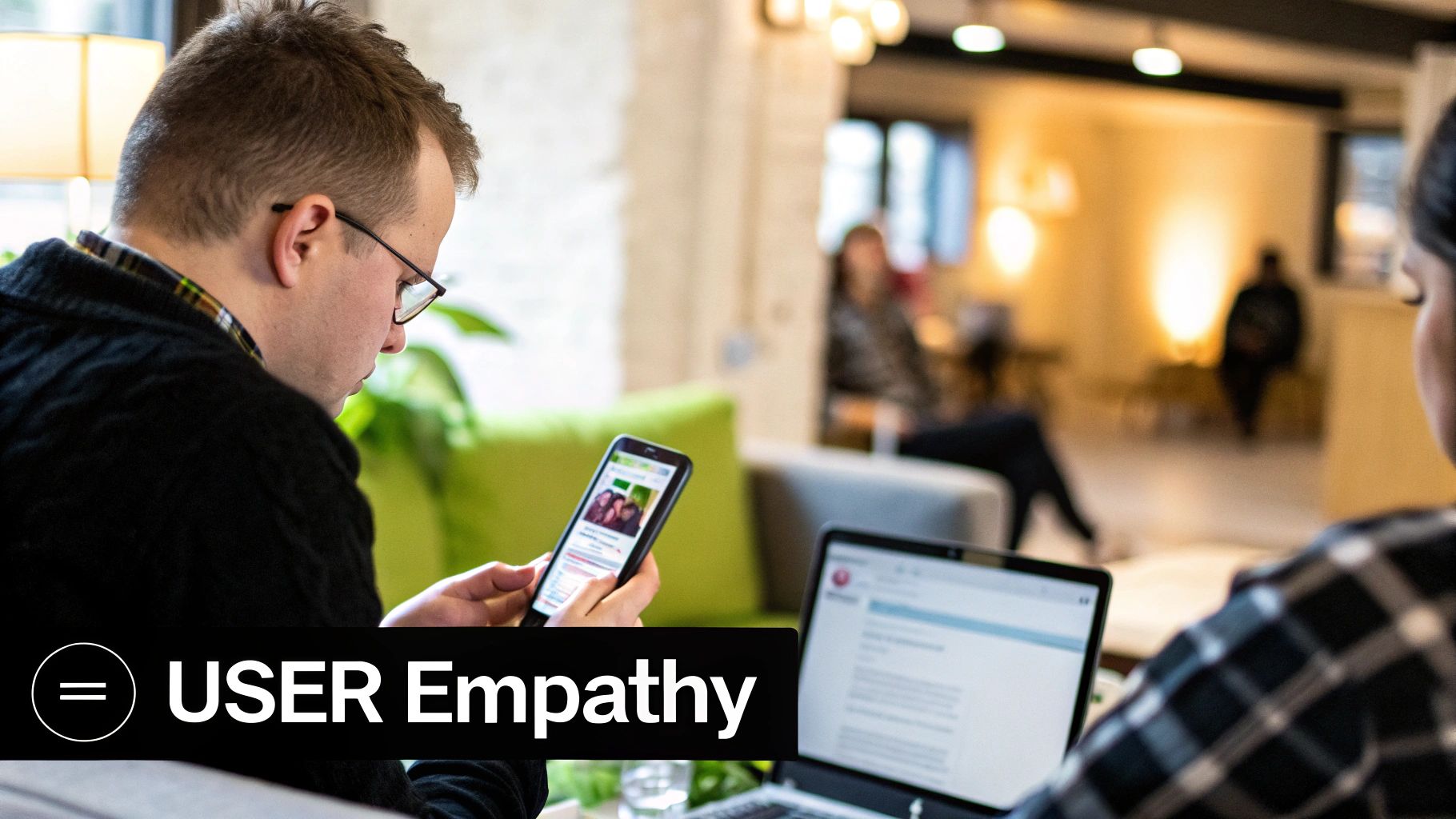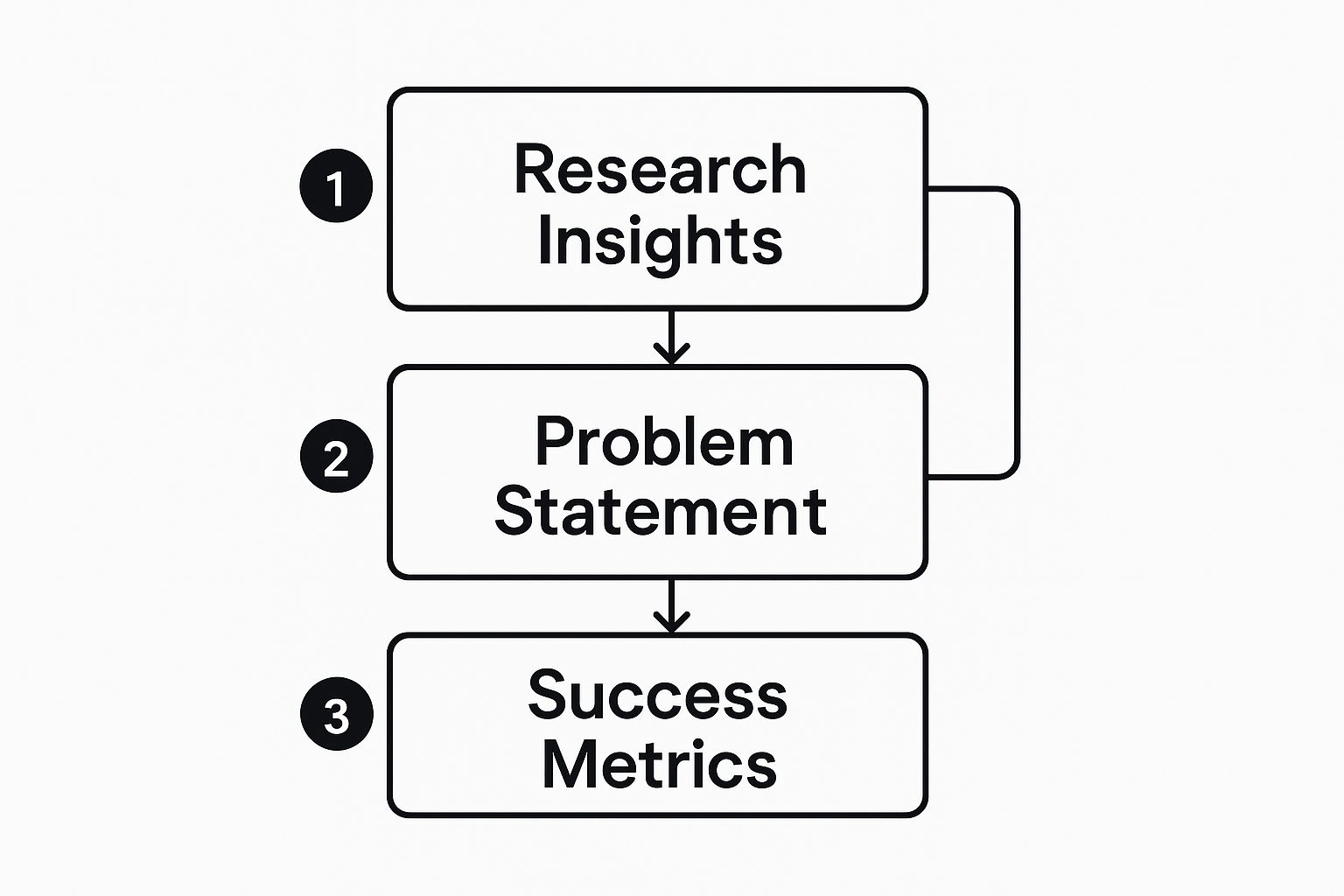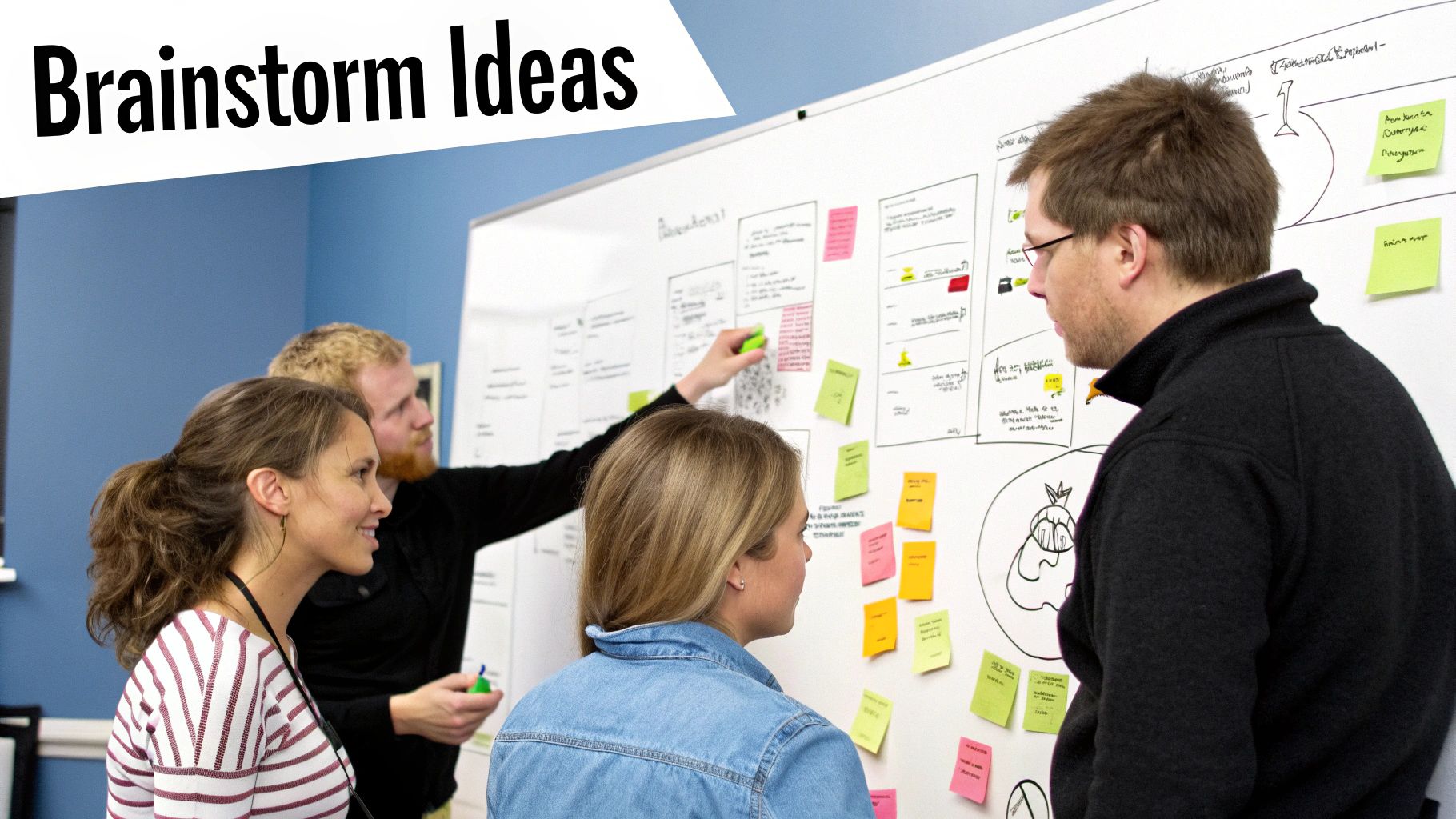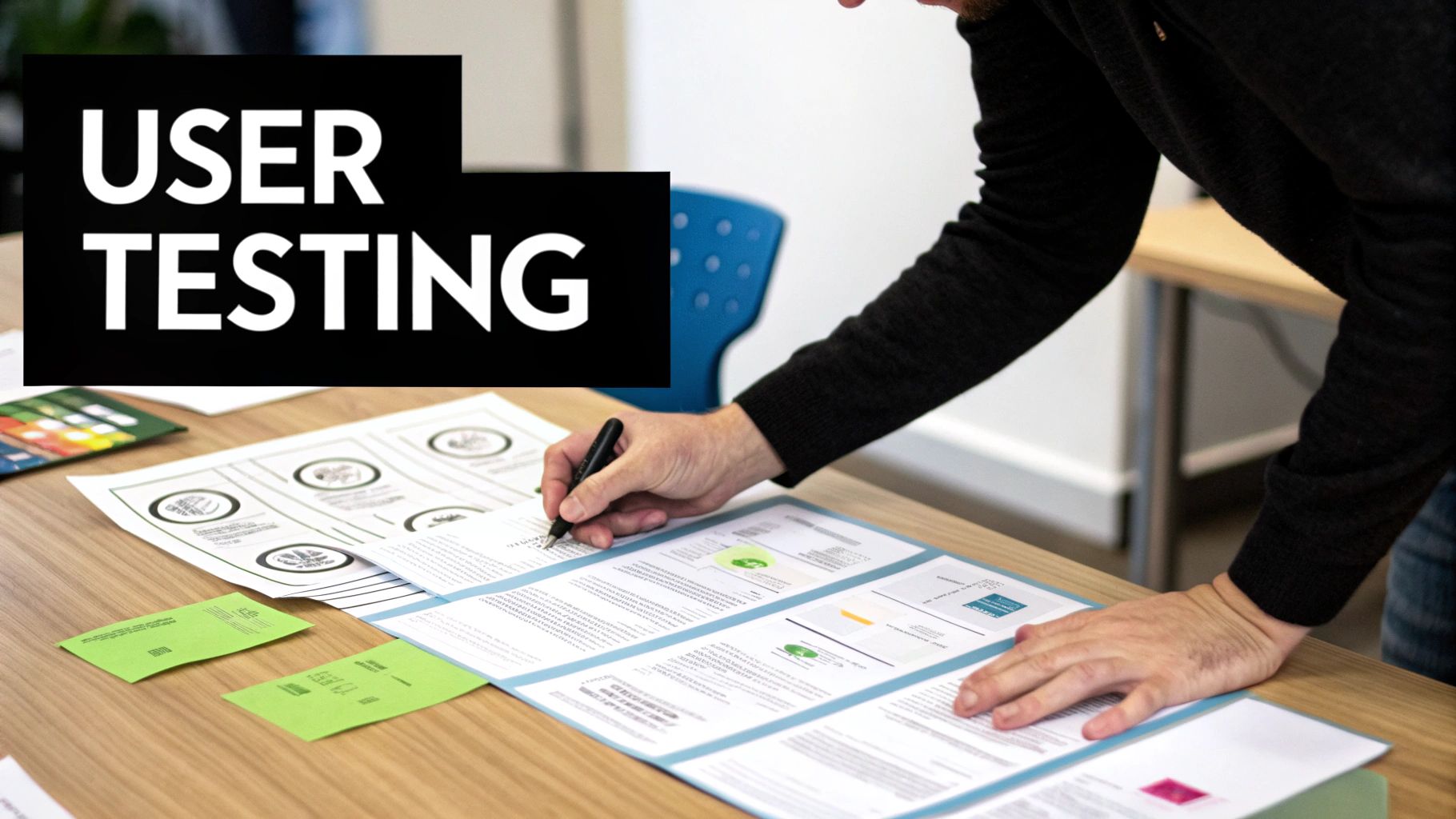Why Most Design Process Steps Fail (And What Works Instead)

Many design processes appear seamless on paper but often struggle when put into practice. Traditional design process steps frequently lack the flexibility to adapt to the ever-changing needs of a project. This inflexibility can lead to missed deadlines, team frustration, and a final product that falls short of expectations. These traditional methods often rely on a waterfall methodology, presuming a linear progression through each phase. However, design rarely unfolds in such a predictable manner.
One common issue is inadequate user research. Without a thorough understanding of the target audience's needs and behaviors, design solutions may miss the mark entirely. A visually appealing app, for example, could fail if it doesn't address the core problem users are trying to solve.
Neglecting stakeholder collaboration can also create misalignment between the design team's vision and the client's objectives. This can lead to expensive revisions and wasted time.
Furthermore, the design process has a rich history and has evolved through various approaches. The evolution of the design process, especially within design thinking, began in the 1960s. This era witnessed the growth of participatory design, which focused on integrating end-users into the project development phase. Learn more about the history of design thinking: https://www.interaction-design.org/literature/article/design-thinking-get-a-quick-overview-of-the-history
Rethinking the Design Process for Success
So, how can we improve the design process? Successful design teams understand the importance of adaptability and iteration. They adopt a more agile approach, allowing for changes throughout the process. This involves continuous feedback gathering and design refinement based on user testing and stakeholder input.
Key Elements of a Successful Design Process
-
Emphasis on User-Centered Design: Every design choice should stem from a deep understanding of the target user. This involves comprehensive user research, including user interviews, surveys, and usability testing.
-
Collaborative Approach: Open communication and collaboration between designers, stakeholders, and developers are essential. Consistent feedback loops ensure everyone stays aligned.
-
Iterative Process: Successful design teams embrace experimentation and iteration. They develop prototypes, test them with users, and refine the design based on feedback.
-
Measurable Outcomes: Setting clear goals and metrics from the beginning helps monitor progress and guarantees the design meets its objectives.
By implementing these principles, design teams can avoid common mistakes and create designs that effectively address user needs and achieve business goals. This creates a design process that is both efficient and impactful.
The Five Design Process Steps That Drive Real Results
Forget complex frameworks. High-performing design teams understand that a streamlined process, focusing on five core steps, consistently delivers results. We'll break down each stage, from initial discovery to final implementation, and explain why each one is crucial for project success. This structured approach takes the guesswork out of design and ensures that the final product meets both user needs and business objectives. You'll also gain insights on how to navigate each phase effectively, avoid common pitfalls, and maintain forward momentum.
1. Discovery: Unearthing the Core Problem
Discovery is about understanding the project's true purpose. It goes beyond simply gathering information; it's about asking the right questions. This includes understanding user needs, analyzing your competitors, and keeping an eye on market trends. This stage sets the foundation for everything that follows. A poorly defined problem will inevitably result in a suboptimal solution, regardless of how well-designed it appears.
2. Definition: Framing the Challenge
After gathering and analyzing information, the next step is to define the problem concisely. This involves synthesizing research insights into a clear, actionable problem statement. This statement serves as a guiding principle throughout the entire design process, ensuring everyone on the team stays focused on addressing the central issue. The infographic below illustrates how to progress from research insights to a problem statement and ultimately define key success metrics.

This structured progression ensures design efforts remain aligned with the identified problem and the intended outcomes. This focused methodology streamlines the entire process, from the initial concept to the finished product.
3. Ideation: Generating Creative Solutions
With a well-defined problem in hand, the ideation phase can begin. This is where creativity comes to the forefront. Teams brainstorm potential solutions, explore different design approaches, and challenge existing assumptions. Think of it as building with LEGOs: you have a specific objective (the defined problem), and you experiment with different brick combinations (ideas) to achieve it. This phase is essential for true innovation. Read also: How to master the principles of design.
4. Prototyping: Bringing Ideas to Life
Prototyping transforms ideas into tangible forms. This can involve creating quick sketches, building interactive mockups using tools like Figma, or developing functional prototypes. Prototyping allows designers to test and refine their concepts before committing significant time and resources to full-scale development. It's about making those abstract ideas real and testable. Most design processes incorporate stages such as discovery, exploration, presentation, and implementation. These stages are often iterative and involve collaboration with various stakeholders, ensuring the design meets the needs of both the client and the end-user. Learn more about current design process steps: Current Design Process Steps
5. Testing: Validating Design Solutions
The final step is rigorous testing. This involves gathering feedback from real users, identifying areas for improvement, and iterating on the design based on those insights. Consider it a scientific experiment: you have a hypothesis (your design solution), and you conduct experiments (user tests) to validate its effectiveness. Testing ensures the final product genuinely meets user needs and achieves its intended purpose.
How Structured Design Process Steps Transform Business Outcomes
What separates thriving design teams from those struggling to make a real impact? The key difference lies in consistently using a structured design process. This organized approach, like a well-oiled machine, helps teams move efficiently through each project phase, minimizing roadblocks and maximizing results. Let's explore how this systematic method can drastically improve business outcomes.
Imagine building a house without blueprints – chaos would surely follow. Starting a design project without clear steps often leads to confusion, endless revisions, and ultimately, a product that misses the mark. A structured approach encourages better teamwork, much like musicians in an orchestra following the conductor to create a harmonious sound.
Measurable Impact of Design Process Steps
Structured design isn't just about organization; it directly affects the bottom line. Using well-defined design process steps can significantly boost client satisfaction. When clients are involved and understand the reasoning behind design choices, they're more likely to be happy with the end product. This satisfaction often leads to repeat business and positive referrals, fueling growth.
Structured processes also result in fewer revisions, saving time and money. By clearly outlining goals and setting checkpoints, teams can catch and fix potential problems early, preventing costly rework down the line. Understanding the different design stages is crucial. For more information, check out this article about the logo design process.
The Benefits of a Systematic Approach
A structured approach allows teams to deliver projects faster and more efficiently. When everyone understands their roles and the steps involved, projects progress smoothly and predictably. This efficiency leads to quicker turnaround times, giving businesses a competitive advantage.

Sticking to proven design process steps consistently produces better final outcomes. By focusing on user needs, doing thorough research, and rigorously testing ideas, design teams create solutions that are both beautiful and effective in achieving business goals.
Incorporating design thinking into business strategies generates significant returns. A McKinsey study revealed that design-led companies outperformed industry peers by an impressive 219% in revenue growth over five years. This highlights the economic impact of design when integrated into core business strategies. Learn more: Find more detailed statistics here.
By investing in and implementing structured design processes, businesses can create a lasting competitive advantage, leading to increased profitability, stronger customer relationships, and a better brand reputation. This structured approach, like a well-designed building, provides a solid foundation for continued success.
Discovery That Actually Uncovers What Matters
Most design projects stumble not due to flawed execution, but because teams rush the crucial discovery phase. Sometimes, they even ask the wrong questions altogether. This initial stage forms the bedrock of the entire design process. Understanding how to unearth valuable insights is essential for success.
This means going beyond surface-level data. It requires a deep dive to understand the underlying needs, motivations, and context surrounding the project.
Stakeholder Interviews: Uncovering Hidden Requirements
Effective stakeholder interviews are key to revealing hidden project requirements. This means talking not just to the client, but also to key individuals affected by the design. Think end-users, sales teams, or customer support representatives.
For instance, interviewing customer service representatives might expose user pain points initially invisible to the client. These interviews should be structured yet conversational, allowing for open-ended responses and valuable insights. You might find this helpful: How to master the creative brief.
User Research: Revealing Actual Behavior Patterns
User research takes us a step further than stakeholder interviews. It focuses specifically on the target audience's behavior. This might involve observing users interacting with existing products, conducting usability tests, or analyzing user data.
This step reveals how users actually behave, not just how stakeholders think they behave. This distinction can be crucial, highlighting unmet needs and areas for improvement. It's like detective work, searching for clues and patterns to build a solid case for the right design solution.
Competitive Analysis: Identifying Real Opportunities
Thorough competitive analysis is crucial for understanding the market. This means not just identifying competitors, but also analyzing their strengths, weaknesses, and design approach.
This process reveals opportunities for differentiation and informs design decisions. A structured design process, much like a well-implemented tool such as sales process automation, can significantly impact business outcomes. By studying what works (and what doesn’t) in the competitive landscape, you can position your design for greater success.
Organizing and Presenting Your Findings
After gathering all this information, organizing and presenting your findings clearly, concisely, and actionably is crucial. This could involve creating user personas, journey maps, or detailed reports summarizing your key insights.
Your presentation should distill complex research data into a clear project direction that all stakeholders can grasp and support. This shared understanding paves the way for a smoother design process and a more successful outcome. This structured approach to discovery provides the necessary foundation for a truly user-centered and effective design.
From Ideas to Solutions That Actually Work

Turning research insights into impactful design solutions requires a structured approach. This section explores ideation techniques that help generate innovative concepts rooted in user needs and business realities. It's about understanding how to run productive creative sessions, evaluate ideas objectively, and select concepts with the highest potential.
Facilitating Productive Creative Sessions
Effective design teams understand the value of structured brainstorming. This means fostering a safe and encouraging environment where everyone feels comfortable sharing ideas. Techniques like "Yes, and…" encourage building on each other's contributions, leading to unexpected solutions and a sense of shared ownership.
Clearly defined goals are also essential for productive brainstorming sessions. Knowing the objectives keeps the team focused and ensures the generated ideas align with the project's purpose.
Evaluating Ideas Objectively
Once you have a collection of ideas, objective evaluation is crucial. This involves establishing clear criteria based on project goals and user needs, such as feasibility, desirability, and viability.
Assessing each idea based on practicality, user appeal, and business potential helps filter out less promising options. This focused approach allows teams to prioritize the ideas with the greatest chance of success. You might find this helpful: How to master creative project management.
Refining Concepts into Viable Design Directions
The next stage involves refining selected concepts into workable design directions. This often includes creating sketches, mockups, or prototypes to visualize ideas and explore variations.
This iterative process lets designers experiment and identify potential challenges early. Gathering feedback from stakeholders and users during this phase helps validate the design direction and ensure it aligns with project goals.
Different Thinking Approaches for Various Project Types
Different projects call for different thinking approaches. Improving an existing product might benefit from an analytical approach, while creating something entirely new might require more divergent thinking.
This adaptability ensures the ideation process is tailored to each project's specific needs. Understanding which tools and techniques are most appropriate for different situations is key to successful design.
Through individual creativity and team collaboration, design teams can bridge the gap between user insights and innovative solutions. By understanding the design process and employing structured ideation techniques, teams can consistently create high-quality solutions that meet user needs and achieve business objectives.
Testing Ideas Before They Become Expensive Mistakes
Good design isn't built on guesswork. Savvy designers know that validating ideas with real users is crucial for success. This section explores practical prototyping techniques that help you test core design aspects efficiently, saving you precious time and resources. We'll look at different prototyping methods suitable for various project stages, from initial concept sketches to interactive user experience prototypes.
Prototyping: From Sketches to Interactive Experiences
The prototyping phase transforms your ideas into tangible forms. This can be as simple as a pen-and-paper sketch or as complex as a fully interactive digital mockup. Early-stage prototypes, such as quick sketches, are invaluable for validating fundamental concepts and gathering initial feedback. As your design progresses, more sophisticated prototypes, like interactive mockups, enable detailed user testing of specific interactions and functionalities.
Think of it like building a scale model before constructing a full-sized building. This lets you test structural integrity and aesthetics without the expense of the real deal. Similarly, design prototypes help identify and address usability issues early in the design process, ultimately saving significant time and resources.
User Testing: Gathering Actionable Feedback
Building prototypes is just the first step. The real magic happens during user testing. This involves observing how real users interact with your prototype, collecting their feedback, and pinpointing their pain points. Well-designed user tests provide specific, actionable insights that inform iterative improvements. This data-driven approach empowers designers to refine their work based on observed user behavior, ensuring the final product truly meets user needs.
Interpreting Results and Making Data-Driven Decisions
After user testing, the focus shifts to interpreting the results. This involves analyzing feedback, identifying patterns, and drawing conclusions about the design's effectiveness. This analysis informs iterative improvements, letting designers refine their solutions based on concrete data. It’s about translating user feedback into tangible design changes. For example, if users consistently struggle with a particular feature, it's a clear indicator that redesign is necessary. Learn more in our article about how to manage creative projects.
Different Prototyping Approaches for Various Phases
Selecting the right prototyping method depends on the project phase and the specific questions you aim to answer. Early on, simple paper prototypes can be surprisingly effective for validating core concepts. As the design evolves, more complex prototypes, like interactive wireframes using tools like Figma or clickable mockups in Adobe XD, become essential for testing detailed interactions and user flows.
To help you choose the best approach, the following table provides a comparison of various prototyping methods and their applications:
Prototyping Methods and Applications
| Prototyping Method | Best Use Case | Time Investment | User Feedback Quality | Implementation Complexity |
|---|---|---|---|---|
| Paper Prototypes | Early concept validation | Low | Basic usability feedback | Low |
| Wireframes | Testing information architecture and layout | Medium | Feedback on navigation and structure | Low-Medium |
| Interactive Prototypes | Testing detailed interactions and user flows | High | In-depth feedback on functionality and usability | High |
This table highlights the trade-offs between different methods, allowing you to select the best fit for your project needs.
By understanding the strengths and weaknesses of each method, you can choose the right tool for the task and gather the most valuable feedback. Using proven testing frameworks and real-world case studies, designers can systematically validate their design choices, ensuring final solutions genuinely work for real users in practical contexts. This structured approach helps teams stay within project constraints while delivering products that are both functional and user-friendly.
Getting Your Designs Built Right (Without Losing Your Mind)
This is where many great design concepts stumble – the implementation phase. A brilliant idea can easily get distorted between the design team and developers. This section offers practical strategies for successful design handoffs, ensuring your vision becomes reality without endless revisions and developer frustration.
Creating Specifications That Actually Get Used
Think of your design specifications as the blueprint for your project. Just like a contractor needs detailed blueprints to build a house, developers need clear specifications to build your design. These specifications should be comprehensive, covering everything from font sizes and color palettes to interactive elements and responsive behavior. Learn more in our article about how to master creative resource management.
This involves creating detailed documentation that's not only thorough but also easily accessible and understandable for developers. Visual aids, like annotated mockups and interactive prototypes, can significantly improve clarity and reduce misinterpretations.
Maintaining Design Integrity Throughout Development
Maintaining design integrity during development requires constant communication and collaboration between designers and developers. Regular check-ins and feedback loops are essential for catching potential issues early and ensuring the design stays true to the original vision. Think of it as quality control checks throughout a manufacturing process.
This proactive approach can prevent costly rework and ensure the final product aligns with the approved design. It also fosters a stronger working relationship between design and development teams.
Collaborating Effectively With Technical Teams
Designers and developers often speak different languages. Bridging this communication gap is essential for a smooth implementation process. This involves learning enough about each other's disciplines to understand constraints and possibilities.
For example, designers should understand the technical limitations of certain design choices, while developers should appreciate the reasoning behind design decisions. This mutual understanding fosters a more collaborative environment and minimizes misunderstandings. It also leads to more creative and effective solutions that balance design aesthetics with technical feasibility.
Practical Approaches for Documentation and Asset Preparation
Clear and concise documentation is crucial for preventing misunderstandings. This involves creating detailed style guides, design specifications, and asset libraries that developers can easily access and reference. Well-prepared assets, such as optimized images and organized design files, can significantly speed up the development process.
This streamlined approach minimizes back-and-forth communication and allows developers to focus on building the product. It also contributes to a more efficient workflow and reduces errors.
Quality Assurance: Catching Issues Before Launch
Implementing a robust quality assurance process is critical for identifying and resolving issues before they reach the end-user. This involves testing the product across different devices and browsers, as well as conducting user acceptance testing to gather feedback and identify areas for improvement. Think of it as a final inspection before shipping a product.
This rigorous testing ensures a high-quality product that meets user expectations. It prevents costly post-launch fixes and maintains a positive user experience.
Boost your creative project management with Creativize. Our platform connects you with top local talent and provides the tools you need to manage projects effectively from start to finish. Start your free trial today!

